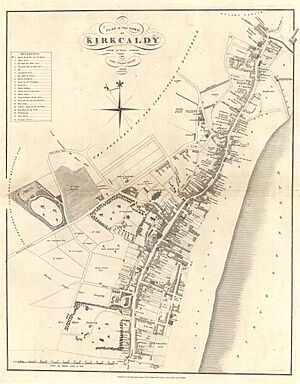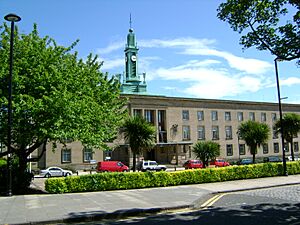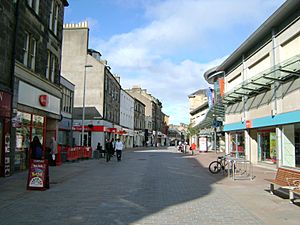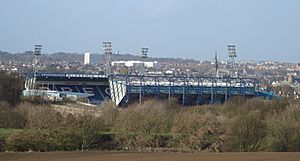Kirkcaldy facts for kids
Quick facts for kids Kirkcaldy
|
|
|---|---|
| Town and former royal burgh | |
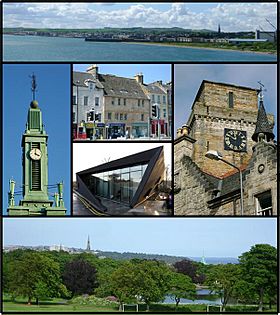 Waterfront and bay (top), Townhouse clock (middle left), Old Kirk (top right), Merchants House/ High Street (top centre) Maggie's Fife (bottom centre), Beveridge Park pond (bottom) |
|
| Area | 6.9 sq mi (18 km2) |
| Population | 50,370 (2020) |
| • Density | 7,300/sq mi (2,800/km2) |
| OS grid reference | NT275915 |
| • Edinburgh | 11 mi (18 km) S |
| • London | 341 mi (549 km) SSE |
| Civil parish |
|
| Council area | |
| Lieutenancy area | |
| Country | Scotland |
| Sovereign state | United Kingdom |
| Post town | KIRKCALDY |
| Postcode district | KY1, KY2 |
| Dialling code | 01592 |
| Police | Fife |
| Fire | Fife |
| Ambulance | Scottish |
| EU Parliament | Scotland |
| UK Parliament |
|
| Scottish Parliament |
|
Kirkcaldy (say "kur-KAW-dee") is a town on the east coast of Scotland, in an area called Fife. It's about 11.5 miles (18.5 km) north of Edinburgh. In 2011, nearly 50,000 people lived there. This makes it the second-largest town in Fife and the 11th most populated place in Scotland.
Kirkcaldy is often called the Lang Toun (which means "long town" in Scots). This nickname came from its main street, which was almost 1 mile (1.5 km) long in the 1500s. Over time, this street grew to nearly 4 miles (6.4 km). It connected Kirkcaldy with nearby villages like Linktown, Pathhead, Sinclairtown, and Gallatown. These villages became part of Kirkcaldy in 1876. Later, in 1930, the town of Dysart also joined Kirkcaldy.
People have lived in the Kirkcaldy area since the Bronze Age. The town was first mentioned in a document from 1075. Back then, King Malcolm III gave the land to the church in Dunfermline. Later, King David I gave it to Dunfermline Abbey. In 1327, King Robert I officially recognized Kirkcaldy as a "burgh" under the Abbey's control. The town became independent from the Abbey in 1644, when King Charles I made it a "royal burgh." This meant it had special rights from the King.
In the early 1500s, a harbour was built, making Kirkcaldy an important trading port. The town also started to grow with industries like salt production, coal mining, and nail making. Later, in 1672, linen production began. This led to the creation of floorcloth in 1847 by Michael Nairn. Then, in 1877, linoleum was invented, which became the town's most successful industry. Kirkcaldy was a major world producer of linoleum until the mid-1960s. The town grew a lot in the 1950s and 1960s. However, when the linoleum industry declined, its growth slowed down.
Today, Kirkcaldy is a main service centre for central Fife. It has a leisure centre, a theatre, a museum, an art gallery, public parks, and an ice rink. Kirkcaldy is also famous as the birthplace of social philosopher and economist Adam Smith. He wrote his famous book The Wealth of Nations here. Most jobs in Kirkcaldy now are in the service industry. Big employers include PayWizard (a call centre), NHS Fife, Forbo (floor coverings), Fife College, Whitworths (flour millers), and Smith Anderson (paper making).
Contents
- History of Kirkcaldy
- How Kirkcaldy is Governed
- Geography and Landscape
- Weather in Kirkcaldy
- Population of Kirkcaldy
- Economy and Jobs
- Culture and Fun Things to Do
- Places of Worship
- Kirkcaldy on Film and TV
- Sports and Fun Activities
- Important Landmarks
- Education in Kirkcaldy
- Public Services
- Media
- Transport in Kirkcaldy
- Famous People from Kirkcaldy
- Twin Town
- See also
History of Kirkcaldy
What's in a Name?
The name Kirkcaldy means "place of the hard fort" or "place of Caled's fort." It comes from an old language called Pictish. The word caer means "fort," and caled means "hard" or could be a person's name. The ending -in means "place of." So, it describes a fort that was strong or belonged to a tough ruler.
Early Beginnings
People lived in this area a very long time ago. About 4,500 years ago, during the Bronze Age, 11 ancient burial sites were found here. This spot was good for living because it had natural flat areas near a sandy bay, and two burns (small rivers) nearby: the East Burn and the West (Tiel) Burn. Even though there aren't many Roman sites in Fife, a Roman camp was known to be on the edge of Kirkcaldy at Carberry Farm.
Medieval Times
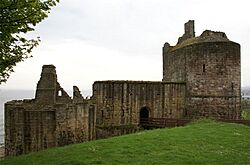
The first time Kirkcaldy was officially mentioned was in 1075. King Malcolm III gave the land of Kirkcaladunt to the church in Dunfermline. People living there had to pay taxes to support the church. Later, in 1304, the Abbot of Dunfermline suggested that Kirkcaldy should have a weekly market and a yearly fair. This was during a time when England ruled Scotland.
In 1327, King Robert I confirmed Kirkcaldy's status as a burgh that belonged to Dunfermline Abbey. This meant the town was under the Abbey's control. In 1363, King David II gave Kirkcaldy the right to trade across the Dunfermline area. This allowed Kirkcaldy's merchants to buy and sell goods with merchants from other towns that belonged to the Abbey. By 1451, Kirkcaldy gained more control over its own affairs. The town's leaders could now manage its daily business and money, as long as they paid a yearly fee to the Abbot.
From the 1500s to the 1700s
In the early 1500s, Kirkcaldy became an important trading port. Its location on the east coast was perfect for trading with countries like the Netherlands, the Baltic region, England, and France. A small harbour was already in use by 1451. Timber, possibly from the Baltic countries, was imported through the harbour and used for building Falkland Palace and Edinburgh Castle.
Raw materials like animal hides, wool, fish, coal, and salt were exported from the town until the 1600s. Ships from Kirkcaldy also brought wine and spices from places like Spain. In 1598, a Kirkcaldy ship called the Grace of God was attacked by an English ship. The Kirkcaldy ship sank.
In 1644, King Charles I made Kirkcaldy a royal burgh. This meant the Abbey no longer controlled the town. The King also gave the town 8 acres (3.3 hectares) of land for "bleaching linen, drying clothes, and recreation." In 1638, the town supported the National Covenant, which opposed changes to the Presbyterian church. This support was costly. The town lost over 250 men in the Battle of Kilsyth in 1645. The ongoing wars led to the loss of many trading ships and at least 480 more men. By 1660, Kirkcaldy had only 12 registered ships, down from about 100 in the early 1640s.
By the late 1600s, the town's economy started to recover, with more manufacturing. Daniel Defoe described Kirkcaldy as a "larger, more populous, and better built town" than others on the coast. Shipbuilding also saw a comeback, with 38 ships built between 1778 and 1793. In the mid-1800s, whaling became important for a short time. The first Kirkcaldy whaling ship sailed in 1813. The last one was sold in 1866, ending the industry. A new main road built in 1790 greatly increased traffic through Kirkcaldy's High Street, helping the town grow stronger.
Modern Times
For most of the 1800s, Kirkcaldy's main industries were flax spinning and linen weaving. To handle more imports and exports, a new dock and pier were built at the harbour between 1843 and 1846. In 1847, Michael Nairn, a canvas maker, started making floorcloth at a factory in Pathhead. When the patent for floorcloth ended in 1876, Nairn and other makers started producing linoleum. By 1883, seven factories in Kirkcaldy made floorcloth and linoleum, employing 1,300 people. The harbour was expanded again between 1906 and 1908 for more linoleum and coal trade. The smell from the linoleum factories was so strong that it was mentioned in a famous poem from 1913: "For I ken mysel' by the queer-like smell / That the next stop's Kirkcaddy!".
The town grew, and in 1876, the royal burgh's borders were expanded. It took in Linktown, Invertiel, Pathhead, Sinclairtown, and Gallatown. These places were once separate and couldn't sell their goods in Kirkcaldy due to old guild rules. Between 1922 and 1923, a seawall and esplanade were built, providing jobs for unemployed residents. In 1930, Kirkcaldy grew even more when it absorbed the town of Dysart, which had gone bankrupt.
In the 1950s and 1960s, new housing estates were built in the north-west of the town. The town centre was also redeveloped, which changed much of the old high street. People thought Kirkcaldy's population might reach 55,000-60,000 by 1970. However, the linoleum industry declined in the mid-1960s, and the population dropped from a high of 53,750 in 1961 to 47,962 in 1981.
In the 2000s, Kirkcaldy is still an important centre for the surrounding areas. It has a Museum and Art Gallery, three public parks, and shopping areas. The town also hosts the yearly Links Market, known as "Europe's longest street fair." Linoleum is still made, but on a much smaller scale. Kirkcaldy Harbour, which closed in 1992, reopened in October 2011 for cargo ships. This helps Carr's Flour Mills bring in wheat by sea, reducing the number of lorries on the roads.
How Kirkcaldy is Governed
When Kirkcaldy gained more control in the mid-1400s, it could manage its own administration and money for the first time. The first mention of a town council was around 1582. The town's main meetings were held in the Common Muir (now called Volunteers' Green) or in the Tolbooth. When Kirkcaldy became a royal burgh in 1644, its leaders included bailies, councillors, and magistrates. The first leader, called a Lord Provost, was Robert Whyt, elected around 1658. Kirkcaldy was one of only four towns in Scotland to use two coats of arms, which were introduced in 1673. One has the motto Vigilando Munio ("I secure by watching"). The other shows Saint Bryce, Kirkcaldy's patron saint.
Kirkcaldy was a royal burgh until 1975. At that time, a new system of local government was created in Scotland. Kirkcaldy became part of the Kirkcaldy District within the Fife region. In 1996, the district council was removed, and Fife Council became the main local authority.
Kirkcaldy is represented by different levels of government. It's divided into six community council areas. Only Dysart, Kirkcaldy North, and Kirkcaldy West have active community councils. These councils share local opinions with the government. The town is also part of the civil parish of Kirkcaldy and Dysart, which is used for statistics.
Fife Council, located in Glenrothes, is in charge of local government for Kirkcaldy. The Kirkcaldy Town House is the main office for the Kirkcaldy area within Fife Council. Kirkcaldy also sends 11 councillors to Fife Council. Beyond local government, the Scottish Parliament handles matters like education, health, and justice for Scotland.
Kirkcaldy is part of the Kirkcaldy and Cowdenbeath area for the UK Parliament. This area elects one Member of Parliament (MP). Since 2017, Lesley Laird of the Labour Party has been the MP. For the Scottish Parliament, Kirkcaldy is part of the Kirkcaldy constituency. It also belongs to the Mid Scotland and Fife region. David Torrance of the Scottish National Party (SNP) won the Kirkcaldy seat in 2011.
Geography and Landscape
Kirkcaldy is built around a sandy bay that faces the Firth of Forth. It's located between two small rivers: the Tiel (West) Burn to the south and the East Burn to the north. The town is about 9.3 miles (15 km) south-southeast of Glenrothes and 18.6 miles (30 km) north-northeast of Edinburgh. Kirkcaldy got its nickname lang toun because of its long main street. This street was nearly 4 miles (6.4 km) long, connecting the town to its nearby areas like Linktown, Pathhead, Sinclairtown, and Gallatown.
Historians aren't sure where the exact centre of medieval Kirkcaldy was. It might have been at the corner of Kirk Wynd and the High Street. This would have been where the town's market cross was, a central point for the burgh. The main street was paved or cobbled. Small burns (streams) ran down the hill towards the sea, crossing the High Street. Behind the houses on the High Street were narrow strips of land called "rigs" that belonged to the town's merchants.
The small burns that flow into the East Burn helped drain the land of Dunnikier Estate. The East Burn flows under a large culvert, through a deep gorge, past Hutchison's Flour Mills, and then into the sea near the harbour. The flour millers chose this area because it had a railway connection to the harbour, not because they needed the burn for power. The West (or Tiel) Burn was also important. It provided power for textile mills. This burn flows from the Raith Estate lands, where it was used to create Raith Lake.
Weather in Kirkcaldy
| Climate data for Kirkcaldy (6 m asl, averages 1991–2020) | |||||||||||||
|---|---|---|---|---|---|---|---|---|---|---|---|---|---|
| Month | Jan | Feb | Mar | Apr | May | Jun | Jul | Aug | Sep | Oct | Nov | Dec | Year |
| Record high °C (°F) | 14.6 (58.3) |
15.3 (59.5) |
21.2 (70.2) |
21.8 (71.2) |
25.7 (78.3) |
28.6 (83.5) |
29.3 (84.7) |
28.4 (83.1) |
25.2 (77.4) |
22.4 (72.3) |
17.1 (62.8) |
14.4 (57.9) |
29.3 (84.7) |
| Mean daily maximum °C (°F) | 7.0 (44.6) |
7.7 (45.9) |
9.5 (49.1) |
12.0 (53.6) |
14.7 (58.5) |
17.1 (62.8) |
18.9 (66.0) |
18.9 (66.0) |
16.6 (61.9) |
13.2 (55.8) |
9.6 (49.3) |
7.2 (45.0) |
12.7 (54.9) |
| Mean daily minimum °C (°F) | 1.2 (34.2) |
1.6 (34.9) |
2.7 (36.9) |
4.1 (39.4) |
6.5 (43.7) |
9.4 (48.9) |
11.5 (52.7) |
11.4 (52.5) |
9.3 (48.7) |
6.5 (43.7) |
3.2 (37.8) |
1.0 (33.8) |
5.7 (42.3) |
| Record low °C (°F) | −14.5 (5.9) |
−15.8 (3.6) |
−11.1 (12.0) |
−4.7 (23.5) |
−0.6 (30.9) |
2.6 (36.7) |
3.4 (38.1) |
3.1 (37.6) |
−0.3 (31.5) |
−6.0 (21.2) |
−9.7 (14.5) |
−15.1 (4.8) |
−15.8 (3.6) |
| Average rainfall mm (inches) | 67.4 (2.65) |
57.6 (2.27) |
56.4 (2.22) |
48.0 (1.89) |
54.3 (2.14) |
64.3 (2.53) |
71.4 (2.81) |
67.8 (2.67) |
60.8 (2.39) |
86.2 (3.39) |
81.8 (3.22) |
81.2 (3.20) |
797.3 (31.39) |
| Mean monthly sunshine hours | 46.5 | 81.4 | 112.6 | 156.0 | 204.0 | 158.3 | 175.3 | 158.8 | 124.8 | 97.4 | 67.9 | 42.6 | 1,425.6 |
| Source: Met Office | |||||||||||||
Population of Kirkcaldy
In the late 1500s, Kirkcaldy's population was estimated to be between 3,000 and 3,200 people. By 1691, it was around 3,400. However, at the start of the 1700s, the population dropped. A census in 1755 recorded about 2,296 people. By the first UK census in 1801, the population had risen to 3,248. It continued to grow, reaching 34,079 by 1901 and 49,050 by 1951.
| Kirkcaldy compared according to UK Census 2011 | |||
|---|---|---|---|
| Kirkcaldy | Fife | Scotland | |
| Total population | 49,709 | 365,198 | 5,295,403 |
| Percentage Scottish identity only | 66.6% | 63.8% | 62.4% |
| Over 75 years old | 8.8% | 7.9% | 7.7% |
| Unemployed | 6.4% | 4% | 4.8% |
The 2001 UK Census showed that Kirkcaldy had 46,912 residents, making up 13.4% of Fife's total population. There were 21,365 households. In 2010, the population was estimated at 49,560, and by the 2011 UK Census, it was 49,709. The wider Kirkcaldy area had about 59,784 people in 2016, and this is expected to increase by 18% by 2026.
In 2016, there were 29,246 households in the Kirkcaldy area. About 67% of these were owned by the people living there. 27% were social rented homes, and 5% were privately rented. About 36% of people live alone, and 16.1% have a low income. The average weekly income for the area is £335.
Most residents (96.52%) were born in the United Kingdom, with 87.15% from Scotland. Compared to the rest of Scotland, Kirkcaldy has fewer immigrants and more people over 75 years old. In 2010, over 7,000 people in Kirkcaldy claimed benefits. In June 2017, about 1,000 people claimed Jobseekers Allowance, which was 2.8% of the population. This rate was higher than the average for Fife and Scotland.
Economy and Jobs
| Kirkcaldy Industry Employed compared according to UK Census 2011 | |||
|---|---|---|---|
| Kirkcaldy Area | Fife | Scotland | |
| Area Committee Total Population (2011) | 59,795 | 366,910 | 5,327,700 |
| All Persons 16–74 in Employment (2011) | 27,040 | 167,326 | 2,516,895 |
| % Primary Industry Employment (2011) | 1.6% | 2.4% | 3.3% |
| % Manufacturing Employment (2011) | 10.1% | 10.0% | 7.7% |
| % Utilities Employment (2011) | 1.2% | 1.4% | 1.6% |
| % Construction Employment (2011) | 8.3% | 8.2% | 8.0% |
| % Wholesale, Retail & Transport Employed (2011) | 21.0% | 18.6% | 19.9% |
| % Accommodation and Food Employed (2011) | 5.3% | 5.6% | 6.3% |
| % ICT Employed (2011) | 2.7% | 3.0% | 2.7% |
| % Finance & Professional Employed (2011) | 18.1% | 19.1% | 20.1% |
| % Public Sector Employed (2011) | 7.4% | 7.8% | 7.0% |
| % Education & Health Employed (2011) | 24.4% | 23.8% | 23.4% |
The first industries in Kirkcaldy were coal mining and salt panning, starting in the early 1500s. Later, coarse cloth and nail making became important. Linen weaving began in 1672, using yarn from other countries. The pottery industry started in 1714, mainly in Linktown, Gallatown, and Sinclairtown. The Fife Pottery, built in 1817, made famous Wemyss Ware pottery.
In 1828, Michael Nairn started making heavy canvas. After visiting Bristol, he began making floorcloth at his new factory in Pathhead in 1847. His company was a pioneer in using ovens to speed up floorcloth production. When the patent for floorcloth ended in 1876, Nairn's company started producing linoleum. By 1883, seven factories in Kirkcaldy made floorcloth and linoleum, employing 1,300 people.
About 22,200 people work in the Kirkcaldy area, mostly in Kirkcaldy itself. Most jobs are in the service sector. Retail and construction are also important, along with finance and business services. The biggest employer in town is MGt plc. Other major employers include NHS Fife, Forbo (vinyl floor coverings), Fife College (education), Whitworths Holdings (flour millers), and Smith Anderson (paper making).
Kirkcaldy's town centre is the largest shopping area in Fife. It serves about 130,000 people. Businesses in the town centre voted for a special improvement scheme in 2010. The High Street, which is near the Esplanade, has the Mercat Shopping Centre. A project to improve the High Street was finished in late 2011. Another project created a "green corridor" to connect the railway and bus stations to the High Street. The total cost for these improvements was £4 million.
A retail park with large stores was built in 1997, north-west of the town. This park was bought by Hammerson, a property developer, in 2005.
Culture and Fun Things to Do
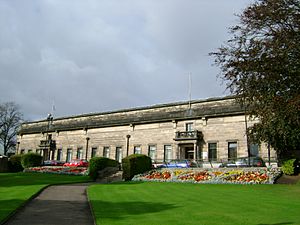
Kirkcaldy Galleries is where you'll find the town's museum, art gallery, and main library. It first opened in 1925 as Kirkcaldy Museum and Art Gallery. It was expanded in 1928 to include a library. In 2011, the building closed for a £2.4 million renovation and reopened in June 2013 with its new name.
The Adam Smith Theatre is Kirkcaldy's main performance hall. It hosts plays, music shows, and movies. It was originally called the Adam Smith Halls. It got its current name in 1973 after being renovated for the 250th birthday of Adam Smith. The King's Theatre, which opened in 1904, is being redeveloped to become the biggest venue in Fife.
The Links Market started as a farmers market on Links Street. In 1903, it moved to its current spot on the Esplanade. This market comes to town every April and celebrated its 700th anniversary in 2004. Kirkcaldy has been twinned with Ingolstadt in Germany since 1962.
Kirkcaldy has three main public parks:
- Beveridge Park: This 104-acre (42-hectare) park was created with money left by Michael Beveridge, a linen manufacturer. It opened in 1892. The park has a boating lake, a formal garden with a fountain, a skateboard park, rugby and football fields, and woodland paths. It has won a green flag award for being a great park. Kirkcaldy parkrun happens here every Saturday.
- Ravenscraig Park: This park is to the east of town. It was given to the town by Sir Michael Nairn, a linoleum manufacturer, in 1929. It's right next to Ravenscraig Castle.
- Dunnikier Park: Located north of town, this park was bought by the town council in 1945. It includes the area around Dunnikier House and has many woodland walks. Dunnikier House was built around 1790.
Places of Worship
There are several places of worship in Kirkcaldy including:
- Church of Scotland
- Abbotshall
- Bennochy
- Linktown linked with Auchtertool
- Pathhead
- St Bryce Kirk
- Templehall, Torbain and Viewforth linked with Thornton
- Roman Catholic
- St Marie's
- St Pius X
- Baptist
- Whyte's Causeway Baptist Church
- Pathhead Baptist Church
- Other Churches
- Connect Church
- Kirkcaldy Free Church
- Newcraigs Evangelical Church
- Redeemed Christian Church of God
- St Peter's Episcopal Church
- Kingdom Hall of Jehovah's Witnesses
- Islam
- Kirkcaldy Central Mosque
Kirkcaldy on Film and TV
- Unveiling of Kirkcaldy War Memorial (around 1925) – Shows crowds and soldiers.
- Road Races (1951–1952) – Includes scenes from Beveridge Park.
- Kirkcaldy Youth Pageant (1952) – Features the Lang Toun Lass and Laddie.
- The Scottish footballer of the year (1957) – About Willie McNaught of Raith Rovers.
- The Queen Among Miners (1958) – Shows Queen Elizabeth II at Rothes Colliery.
- Fine Floors (around 1963) – A promotional film for Michael Nairn and Company Ltd, linoleum makers.
- Kirkcaldy (1975) – A film guided by a cartoon disc jockey, looking at the town.
- The 700th (2005) – About the 700th anniversary of the Links Market.
- The Town that Floored the World (first shown: BBC2 21 May 2018) – About Kirkcaldy and the linoleum industry.
Sports and Fun Activities
Raith Rovers F.C. is Kirkcaldy's professional football team. They play in the Scottish Championship, which is the second level of Scottish football. Their home ground is Stark's Park. The club was started in 1883. They had their best league finish in the 1921–22 season, coming in third. In the 1937–38 season, they set a British record by scoring 142 goals in 34 matches. In 1994, they won their first national trophy, the Scottish League Cup, by beating Celtic in a penalty shootout. This win allowed them to play in the UEFA Cup the next season, where they reached the second round before losing to Bayern Munich.
Another senior football team, Kirkcaldy & Dysart, plays at Denfield Park. Kirkcaldy United was also a senior team in the town but closed in 1916.
Kirkcaldy RFC is the senior rugby team. They play at Beveridge Park. Fife Flyers, started in 1938, is the oldest ice hockey team in the United Kingdom. They play at the Fife Ice Arena and have been part of the Elite League since 2011–12. Dunnikier Cricket Club plays at Dunnikier Park, and a flag football club plays at Beveridge Park. The town has a swimming pool, an ice rink, and two golf courses (Kirkcaldy and Dunnikier). In August 2019, Kirkcaldy held its first half marathon in almost 30 years.
Fife Steel Basketball Club is Kirkcaldy's only official basketball club. They have teams for different age groups and play in national and regional competitions.
A new £15 million leisure centre opened on the Esplanade in September 2013. It replaced the old Kirkcaldy Swimming Pool. Building it on this site was a bit controversial because it meant losing a public car park. A group called Save The Car Park gathered over 7,000 signatures to keep the car park open.
Local running clubs include Kirkcaldy Wizards and Fife Athletic Club.
Important Landmarks
The oldest church in Kirkcaldy is the Old Kirk, which is the old parish church on Kirk Wynd. It was first officially recognized in 1244. The main part of the church was renovated between 1807 and 1808. Only the square western tower, built around 1500, was kept. This tower is now the oldest building in the old town. In 2000, the Old Kirk joined with St Brycedale Church. It stopped being used for regular church services in 2008. However, it has since reopened and is used for music and theatre performances. Other important churches include St Bryce Kirk, built between 1877 and 1881; Abbotshall Parish Church, finished in 1788; and Linktown Church, built in 1830–31.
Kirkcaldy Town House on Wemyssfield is the main building in the town's civic square. It was designed in the late 1930s. Work was delayed by World War II and finished in two parts: the west wing in 1953 and the east wing in 1956.
Kirkcaldy War Memorial, in War Memorial Gardens, was unveiled in 1925. It was a gift from John Nairn, a linoleum maker, in memory of his son Ian, who died in the First World War. A memorial for the Second World War was added in 1958. It remembers 1,012 people from the First World War and 452 from the Second World War. Kirkcaldy Galleries, which was also donated by Nairn, is a central part of these gardens.
In the north-east are two homes of early wealthy merchants and shipowners. The Merchant's House (or Law's Close) at 339–343 High Street is one of the best examples of a 16th-century town house in Scotland. Sailors' Walk, at 443–449 High Street, has two 17th-century houses built on foundations from around 1460.
North of the harbour, on The Path, are two buildings with unique designs. Hutchison's House was designed in 1793. Path House, originally called Dunnikier House, is a three-story house built in 1692.
Two large stately homes also exist within the town. To the north of Kirkcaldy is Dunnikier House, built in the late 1700s for the Oswald family. To the south-west of Kirkcaldy is Raith House, built in the late 1600s. It remains a private home today.
To the east of the town are the ruins of Ravenscraig Castle. King James II started building the castle in 1460 for his queen, Mary of Guelders. It was meant to defend the area and protect Kirkcaldy's harbour from pirates and English rivals. Ravenscraig is one of the first British castles designed to defend against and use cannons. Its massive walls and deep ditch show this. After the King died in 1460, work continued, and it became a home for Mary of Guelders until she died in 1463. In 1470, King James III gave the castle to William Sinclair.

Education in Kirkcaldy
The first school in Kirkcaldy was Kirkcaldy Burgh School, a grammar school, started in 1582. Famous students included Robert Adam and Adam Smith. The school moved to a new building in 1843. In 1893, Michael Barker Nairn, a linen manufacturer, gave the town a new building for the school. Other schools were also set up, including girls' schools and schools for apprentices. In 1872, a new law made school-based education compulsory for all children aged 5 to 13.
Kirkcaldy has four secondary schools and eleven primary schools. There's also a private school and a school for children with learning difficulties. Kirkcaldy High School, the oldest secondary school, serves students in the north of town. It has been on Dunnikier Way since 1958. Balwearie High School opened in 1964 and became a high school in 1972. It serves students in the west of town and nearby Kinghorn and Burntisland. Viewforth High School, which opened in 1908, also became a high school in 1980. Plans are approved to build a new secondary school for Kirkcaldy East by August 2016. St Andrews RC High School, opened in the late 1950s, is one of two Roman Catholic secondary schools in Fife. It serves students from St Andrews to Burntisland and Lochgelly.
For further education, Fife College has its main campus on St Brycedale Avenue. This college was formed in 2013 by combining Adam Smith College and Carnegie College. The University of Dundee also has a campus in Kirkcaldy for Nursing and Midwifery studies. The university took over this campus in 1996.
Public Services
Waste management is handled by the local authority, Fife Council. Kerbside recycling operates in the town. A four-bin collection is in place for the majority of residents. Kirkcaldy has one recycling centre and several recycling points. Non-hazardous waste is sent to landfill.
Health care is supplied by NHS Fife, who have their main headquarters in the town. The Victoria Hospital is the town's main general and maternity hospital. A new £152.5 million extension to the hospital was completed in February 2012. This new wing contains a maternity unit, children's department, 11 operating theatres and a new Accident and Emergency Department. Within the grounds of the hospital, a Maggie's Centre provides care for cancer patients. This centre, completed between 2004 and 2006, was the first building in the UK designed by Zaha Hadid. Whyteman's Brae Hospital, also part of the complex, serves psychiatric and elderly patients.
Statutory emergency fire and rescue services are provided by the Scottish Fire and Rescue Service. The main fire station is on Dunnikier Road. Policing in Kirkcaldy is operated by Police Scotland. The main police station is on St Brycedale Avenue. Kirkcaldy is also served by the East Central Region of the Scottish Ambulance Service.
Media
There are three radio stations in the town. Kingdom FM broadcasts from its studios in the town. Victoria Radio Network is a hospital radio station based in Victoria Hospital. K107 is a community radio station.
Transport in Kirkcaldy
Train Travel
Kirkcaldy railway station is north-west of the town centre. It is on the route for the Fife Circle Line and the East Coast Main Line. Trains also run to locations such as Aberdeen and Inverness to the north. To the south, trains go as far as London King's Cross and Penzance. Nearby stations include Burntisland and Kinghorn.
Roads for Driving
The A92 road connects Dunfermline in the west with Glenrothes and Dundee to the north. It passes just north of Kirkcaldy. The A910 road connects it to the western and central parts of the town. At Redhouse roundabout, the A921 connects the A92 to the eastern side of Kirkcaldy. It continues via St Clair Street and The Esplanade on to Kinghorn, Burntisland, and Aberdour to the south-west. The main route through the north of the town, the B981, runs roughly parallel to and one kilometre to the south of the A92. This road also connects to the A910 and the A921. From here the A915, known locally as the Standing Stane Road, connects the town to St Andrews and Leven to the north-east. The A955 runs along the coast from Dysart to East Wemyss and Buckhaven to the north-east.
Bus Services
The main bus station is located between Hill Place and Hunter Street.
Famous People from Kirkcaldy
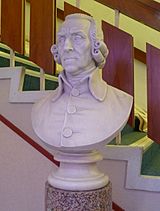
Kirkcaldy is the birthplace of social philosopher and economist Adam Smith, who wrote The Wealth of Nations at his mother's house. Architect and designer Robert Adam (and his father, William) came from the town. Sir Sandford Fleming (1827–1915), an engineer and inventor who helped create worldwide standard time zones, was born here before moving to Canada. Explorer John McDouall Stuart, who led expeditions across Australia, was born in nearby Dysart.
Politicians who come from the town include Henry Balnaves (around 1512–1570), a Scottish politician and reformer; Ronald Munro Ferguson, who was the Governor-General of Australia from 1914 to 1920; David Steel, who led the Liberal Party; and Bertha Wilson, the first female judge of the Supreme Court of Canada. The former Prime Minister Gordon Brown was brought up in the town.
The mathematician Edward Sang was born in Kirkcaldy in 1805.
Patrick Don Swan (1808–1889) founded Swan Brothers shipbuilders. He was the Provost (leader) of Kirkcaldy for 37 years.
The Scottish crime writer Val McDermid was born in the town.
Guy Berryman, the bassist for the band Coldplay, was born and grew up in the town until he was thirteen.
Richard Park, a chief executive of Global Radio and a headmaster on the BBC show Fame Academy, was born in the town.
Sports figures include two-time world darts champion Jocky Wilson, footballer Colin Cameron, professional golfer Peter Whiteford, ice hockey player Adam Walker, and stock car driver Gordon Moodie. William Arnott (1827–1901), a biscuit maker in Australia, also came from the town. David Danskin, who grew up in Kirkcaldy, helped start Dial Square FC, which later became Arsenal. Raith Rovers F.C. footballer Lewis Stevenson was born in Kirkcaldy. He is the only player in his club's history to win both the Scottish League Cup and Scottish Cup.
Frederick Coutts, the 8th international leader of the Salvation Army, was born in Kirkcaldy.
The zoologist Prof David Raitt Robertson Burt (1899–1983) and the botanist John Muirhead Macfarlane (1855–1943) were both born and raised in Kirkcaldy.
The Very Rev John Drysdale, who was twice the leader of the Church of Scotland, was born and raised in Kirkcaldy.
Prof Carstairs Cumming Douglas, a physician, was born in Kirkcaldy. He was important in making Carbolic soap mandatory in Scottish schools in 1907.
Sir David Christie Martin (1914–1976) was born and raised in Kirkcaldy.
Dave Dryburgh, born in Kirkcaldy in 1908, later became a sports journalist and is in the Canadian Football Hall of Fame.
The artist Frances Walker was born in Kirkcaldy in 1930.
Twin Town
- Ingolstadt, Germany
See also
 In Spanish: Kirkcaldy para niños
In Spanish: Kirkcaldy para niños



